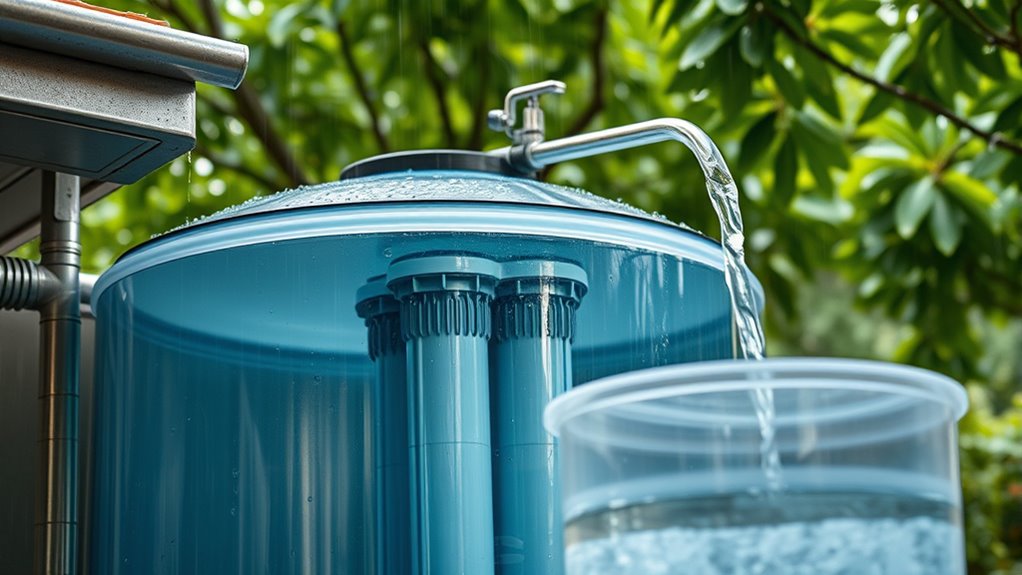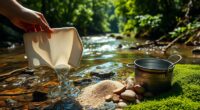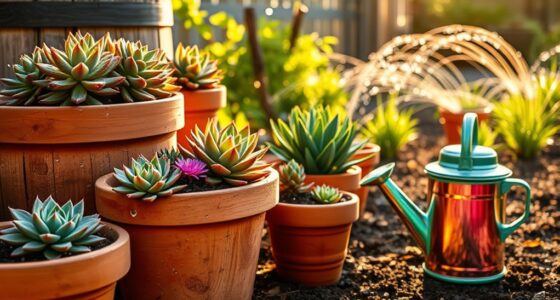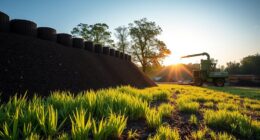To guarantee a reliable emergency water supply, you should set up a rainwater harvesting system by collecting water from roofs or catchment surfaces, filtering out debris, and storing it in sealed, food-grade tanks. Use simple physical filters combined with chemical or UV treatments to eliminate pathogens. Regularly maintain your system by cleaning filters and tanks, keeping spare supplies, and practicing collection procedures. Keep exploring to discover detailed steps that help keep your water safe and ready when emergencies strike.
Key Takeaways
- Collect rainwater from roofs or catchment surfaces using simple filtration to remove debris before storage.
- Use sealed, food-grade tanks and practice regular cleaning to maintain water quality for emergencies.
- Combine physical filters with chemical or UV treatments to ensure safe, pathogen-free drinking water.
- Store water in shaded, cool areas and label containers clearly for quick access during crises.
- Regularly maintain and test the system, keeping supplies like filters and purification tablets ready for emergency use.

When disaster strikes and access to clean water becomes limited, rainwater harvesting offers a reliable emergency solution. You can collect rainwater directly from your roof or other catchment surfaces, which provides an immediate source of water that can be stored for later use. The key to making this water safe for drinking and cooking lies in effective rainwater filtration and proper emergency storage. Without these steps, the water you collect may contain contaminants, pathogens, or debris that can pose health risks.
Start by installing a simple yet effective rainwater filtration system. A basic filter can remove leaves, dirt, and larger particles from the water as it flows into your storage tank. For emergency situations, consider adding a finer filter or a portable water purifier to ensure the water’s safety. Using a combination of physical filters and chemical treatments, such as chlorine tablets or UV purifiers, can help eliminate bacteria, viruses, and other harmful microorganisms. Always remember, the cleaner your initial filtration, the easier it is to make the water safe for consumption.
Your emergency storage setup is equally crucial. Use a clean, covered tank to prevent contamination from animals, insects, or debris. The storage container should be made of food-grade materials and sealed tightly to keep out dirt and pests. It’s wise to have multiple containers so you can store enough water for your household’s needs during an emergency. Label the tanks clearly, and keep them in a shaded or cool area to slow down algae growth and maintain water quality longer. Regularly inspect and clean your storage units, especially before an emergency, to ensure they remain hygienic and ready for use. Additionally, adding UV sterilization can further improve water safety by targeting microorganisms that may bypass filtration.
In a crisis, the combination of reliable rainwater collection, proper filtration, and secure emergency storage can make a significant difference. It’s essential to plan ahead by setting up these systems before disaster hits. Practice collecting and purifying water, so you’re familiar with the process when it’s needed most. Keep spare filters, purification tablets, and cleaning supplies on hand, and stay informed about local water safety guidelines. This proactive approach ensures you’ll have access to safe, drinkable water when traditional sources become unavailable. Additionally, understanding efficient general ledger coding can help manage your emergency supplies budget more effectively and ensure proper record-keeping for your water resources. Rainwater harvesting isn’t just about sustainability; it’s about resilience in times of crisis, giving you a dependable resource to protect your health and well-being during emergencies. Proper maintenance of your systems is also key to ensuring long-term functionality and water safety.
Frequently Asked Questions
How Much Rainwater Can a Typical Household Harvest Annually?
You can typically harvest enough rainwater annually to meet your household needs, but rainfall variability affects this amount. The actual harvest depends on your roof size and storage capacity. For example, with a 1,000-square-foot roof and an average annual rainfall of 30 inches, you could collect around 15,000 gallons. Ensuring adequate storage capacity helps you maximize harvests despite fluctuations in rainfall throughout the year.
What Are the Initial Costs of Setting up a Rainwater System?
Did you know that initial setup costs for rainwater systems can range from $500 to $2,500? A thorough cost analysis helps you understand equipment expenses like gutters, filters, and storage tanks. These upfront investments vary based on system size and quality. While it might seem costly initially, you’re investing in reliable, sustainable water access, which can save money long-term and reduce dependence on municipal water sources.
Can Rainwater Harvesting Be Effective in Urban Environments?
You can make rainwater harvesting effective in urban environments by addressing pollution challenges and integrating it into urban infrastructure. While pollution from vehicles and industries can contaminate rainwater, proper filtration and storage systems guarantee safe usage. Urban infrastructure improvements, like green roofs and permeable pavements, can maximize rainwater collection. This approach helps supplement water needs, reduces runoff, and promotes sustainable water management despite the pollution challenges cities face.
How Long Can Purified Rainwater Be Stored Safely?
Think of purified rainwater as a delicate flower—beautiful but needing care. You can store it safely for about a week if you use proper storage techniques, like airtight, opaque containers that prevent light and contamination. Water contamination risks increase over time, so regular testing and maintaining cleanliness is key. After a week, even the best storage isn’t enough; bacteria and other contaminants can start to develop.
Are There Government Incentives for Rainwater Harvesting Systems?
You might wonder if government incentives exist for rainwater harvesting systems. Many governments offer grants and tax incentives to encourage sustainable water practices. These programs can help offset installation costs and promote eco-friendly solutions. Check with your local or national agencies to see what’s available in your area. Taking advantage of government grants or tax incentives can make installing a rainwater harvesting system more affordable and accessible.
Conclusion
Just like the phoenix rising from ashes, rainwater harvesting and purification empower you to turn scarcity into abundance in emergencies. By harnessing nature’s gift and ensuring its purity, you become the hero of your own story, ready to face any crisis. Remember, with thoughtful planning and swift action, you can transform a simple rainfall into a reliable lifeline—because, like the legend of the flood, preparedness can help you emerge stronger and self-sufficient.










